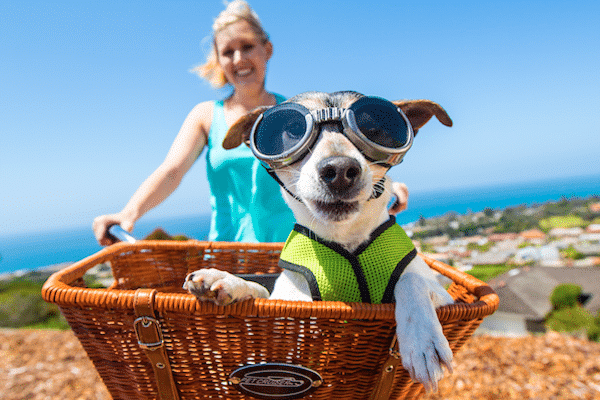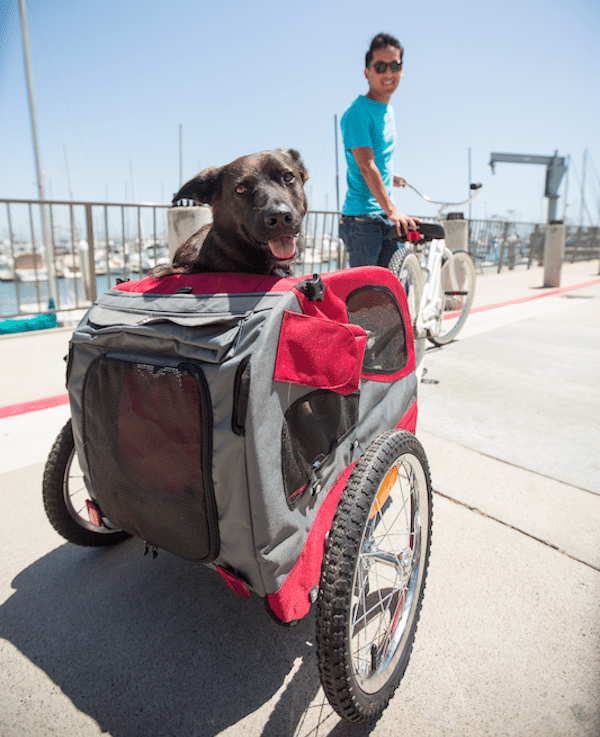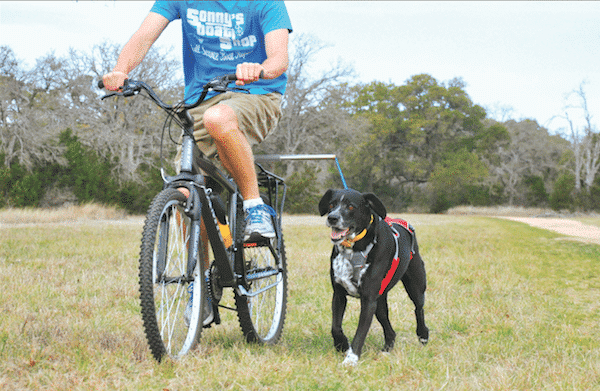Editor’s note: Have you seen the new Dogster print magazine in stores? Or in the waiting room of your vet’s office? This article appeared in our August-September issue. Subscribe to Dogster and get the bimonthly magazine delivered to your home.
Do you love bicycling but hate leaving your dog on the couch? Whether your dog is trotting by your side or just hitching a ride, there are practical ways to include most dogs in biking adventures. With a little preparation, bike rides can add variety to a dog’s exercise routine or give you both more quality time together.
Run or ride? Your dog’s health decides!
Want your four-legged pal to run beside you? Joyce Kesling, owner of Responsible Dog & Cat Training and Behavior Solutions, LLC, said that “biking is for medium to large size dogs” who have stopped growing. She suggested checking with a vet if you’re biking with dogs that are slightly younger.
What if your dogs can’t keep up with a bike or get nervous in public? J. Leslie Johnson, author of Bike With Your Dog: How to Stay Safe and Have Fun, said carriers or trailers are great options for dogs with flat noses, short legs, or special needs. Sturdy and secure, they “can provide a safe place for these dogs to ride comfortably.”

Baskets should provide secure attachments for your dog’s harness so he can’t jump out. Solvit’s Tagalong Wicker Bicycle Basket; $89.99. (Photo by Gina Cioli/Lumina Media)
Choosing your bike and gear
What kind of bicycle should you ride? Scott Daughtry, co-founder of The Dog Outdoors, has worked with clients who have used “everything from low-cost beginner bikes to high-end mountain bikes, adult tricycles, and even folding bikes.” The most reliable bikes for dog biking are wide-tire models that offer balance, support, and traction.
Biking with dogs is safer than ever, thanks to specially designed kits for the bicycle seat or rear axle. These hands-free attachments keep dogs at a safe distance from the bike and prevent wear and tear on their necks by clipping to a padded harness. Manufacturers’ product information will tell you if a harness is good for biking.
Looking for baskets or trailers for dogs who can’t run with a bike due to age or health concerns? Let your dog’s comfort, safety, and size guide your choice. Scott recommended selecting one that “holds your dog in place and does not allow them to accidentally jump out.” The best carriers include secure attachments, both to the bike and to the dog’s harness.
Dog, meet bicycle
Whether they’re running or riding, introduce your dog to bicycling gradually. To J. Leslie, this means giving a dog “the opportunity to check out the leash you plan to use as well as the bike,” advice that applies equally to carriers. Joyce recommended “walking the bike with your dog on lead” until he’s familiar with its motions and sounds.
For dogs who pull or are easily distracted, some simple obedience training may be needed. Why? Joyce said that when it comes to making turns, slowing down, stopping, or riding past distractions, “we can’t bike dogs safely if they don’t understand what we need.” Ready to hit the road? J. Leslie advised beginners to “bike with the dog every other day” for “15 minutes of easy cycling” in a place with few distractions.
These rules of thumb are just as useful for dogs riding in baskets and trailers. Cratetrained dogs may have a leg up, so to speak. Like a good crate, the right bike carrier is one suited to a dog’s size and weight. Let your dog have time to sniff and explore a new carrier on the floor of your home well before your first ride.

Take your dog along for the ride in a trailer. Finding the right one for your dog depends on his size and weight. When in doubt, check with your vet. Solvit’s Medium HoundAbout Bicycle Trailer, Steel; $224.99. (Photo by Gina Cioli/Lumina Media)
Start slow on softer ground
Dogs need time and practice to toughen up their paws for an activity that’s higher-impact than their usual walks. According to J. Leslie, “when you are cycling, you don’t expend much energy, but your dog is working all the time.” The gentler the terrain and the slower your pace, the better for your dog. Even energetic dogs can be put off biking if you go farther and faster than their bodies can handle.
Terrain makes a difference, too. Paved, rocky, or uneven roads are harder on a dog’s limbs and paws than greenways or park trails. Since these softer surfaces are not available to everyone, try varying where you ride. J. Leslie agreed that people should “cycle on a variety of surfaces” to “condition the dog’s pads and joints,” and aim for rides of no longer than 30 to 45 minutes.
Conditioning extends to communication. To keep dogs alert and responsive, J. Leslie said bikers should “avoid talking” and biking at the same time, “except for giving commands.” Pair that with Joyce’s advice: Keep a calm, low tone of voice when telling your dog to slow down or stop during the ride.
Pace yourselves, and have fun!
A steady trot or riding pace, with plenty of breaks during the ride, will help satisfy your dog’s needs for exercise, play, and companionship. With practice, you’ll find a happy balance between starting and stopping, pace and distance, and exercise and fun. Ultimately, the point of dog biking isn’t endurance, but enjoying the ride!
As passengers or participants, Scott said dogs should feel like “going for a bike ride is no different than going
for a normal walk or jog.” All the prep work you put in ensures that your dog is not only comfortable around a bike on his maiden voyage but also eager to join you every time after!

Bike tow leashes attach to the bike and your fully grown dog’s harness. (Photo courtesy The Dog Outdoors)
6 quick tips for peddling with pups
1. Run or ride — Leash attachments are for fully-grown dogs around 25 pounds and up. Secure carriers and trailers are best for small or older dogs. Any doubts? Check with your vet.
2. Get your dog comfortable — Running beside or just along for the ride, your dog should be familiar with any gear, including the bike, leash attachment, or carrier.
3. Safety first — Protective eyewear and helmets designed for dogs are available for extra security or for
fashion-conscious owners who want their pets to look like car enthusiasts from the 1920s.
4. Limit distractions — J. Leslie said that “traffic is probably the single largest hazard in dog biking” and that riders should “choose a biking route with as little traffic as possible.”
5. Watch the weather — Summer’s heat affects dogs quickly, so ride in the early morning or late afternoon. Watch your dog for signs of overheating!
6. Everything in moderation — Keep your dog’s pace to a trot, his treats bite-sized, and offer small sips of water during breaks.
The post How to Bike With Your Dog appeared first on Dogster.
No comments:
Post a Comment